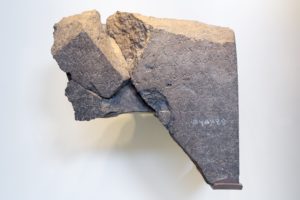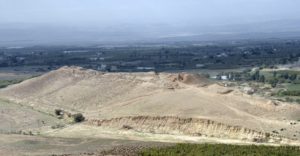Because of the fantastic story of his rise to power—and the lack of corroborating archaeological evidence—many historians and critics doubted the existence of king David and his reign in the 10th century BC. The prevailing academic theory became that he was just a mythological hero, much like King Arthur.
However, the 1993 discovery of the Tel Dan stele immediately changed that view. This artifact is an Aramean victory stele erected in the 9th century BC to commemorate victories over Israel and Judah. Line 9 of the stele references the “House of David” and recognizes it as the original ruling lineage of Israel.1 This text is important because it proves the existence of King David and verifies that he was known as the first ruling dynasty of Israel, even to the neighboring Arameans. That latter fact is especially important since it provides “enemy attestation” of David and cannot be construed as Hebrew propaganda.
In addition, the 9th century Moabite Mesha stele also appears to refer to the “House of David” and provides another example of “enemy attestation” of both David’s existence and royal legacy.2
In addition to the evidence for David, there is also support for the existence of his nemesis, Goliath. According to the Bible, Goliath was the massive champion of the Philistine army that David defeated in one-on-one combat with God’s help. Interestingly, the name “Goliath” was found inscribed on a piece of 9th– or 10th-century pottery in the city of Gath, the Philistine capital3 and Goliath’s hometown. While we cannot know if this is referring to the biblical Goliath, it proves that the name was used by the Philistines during the same time period as the story of David.
In conclusion, the two steles and the Gath pottery provide conclusive evidence of David’s existence during the biblical time period and demonstrate the plausibility of his enemy. Yet again, the critics, who were so confident in their claims against the Bible, were proven wrong. Ironically, their views were overthrown by the enemies of Israel!
Sodom and Gomorrah
The destruction of the cities of Sodom and Gomorrah as punishment for their sinfulness is another story that critics often challenge due to its supernatural and supposedly “judgmental” nature. Nevertheless, biblical archaeologists have long sought to find these cities and multiple options have been identified.
Perhaps most interesting, the ancient city of Tall el-Hamman is a leading candidate for the city of Sodom. Dr. Steve Collins notes forty specific geographic markers about the cities of the southern Jordan valley from the Bible that support this theory.4
When Tall el-Hamman was excavated, many interesting facts were discovered that line up exceptionally well with the biblical story of Sodom’s destruction5:
- The city was catastrophically destroyed by fire, with ash layers as deep as three feet in some locations
- The fire damage was extensive, including architectural destruction of roofs, dwellings, walls, fortification barriers, and personal items including jewelry, pottery, and tools.
- Many of the inhabitants’ bones were charred and distorted, showing evidence of a violent, high-heat flash event that appears to have thrown people to the western side of their dwellings.
- The heat was high enough to turn desert sand into glass and was likely well above 2,000 degrees F! Such temperatures are most commonly associated with lighting, airbursts, or atomic explosions.
- The destruction occurred during the Middle Bronze Age, consistent with the timing of Sodom.
- Despite a good location for trade and water, the city was abandoned after its destruction for centuries, consistent with other biblical verses about the complete destruction of the cities.
In addition to the archaeological evidence specific to Tall el-Hamman, we have secular histories that also attest to the destruction of Sodom and Gomorrah.6 The Jewish historian Josephus Flavius and the Dead Sea scrolls both reference the cities and their fate. The Jewish philosopher Philo even recorded that the destruction of Sodom and Gomorrah could still be seen in his day (roughly 20 BC – 50 AD). In totality, we have significant historical and archaeological evidence that is completely consistent with the biblical stories about these cities.
Notes:
- Kennedy, Titus. Unearthing the Bible. Harvest House Publishers 2020. 98-99
- Ibid, Pg. 99
- Ibid, Pgs. 94-95
- Geisler, Norman and Holden, Joseph M. The Popular Handbook of Archaeology and the Bible. Harvest House Publishers 2013. Pg. 215
- Ibid, Pgs. 217-218
- Price, Randall. The Stones Cry Out. World of the Bible Ministries, Inc. Pgs. 112, 409


